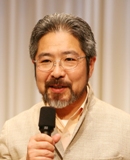New Trend in Manufacturing
May 12, 2010
Mr. Manabu Akaike
President, Universal Design Intelligence Inc.
 ��I have been one of the judges for the Good Design Award sponsored by the Ministry of Economy, Trade and Industry (METI) since 2000. What is noteworthy is that nominees for the Awards of various divisions have changed largely since 2005, the year of Aichi Expo, with home electrical appliances and mobile phones from South Korea accounting for nearly 40%. Also, products from China have been increasing in the past couple of years. Functions of these products are equal to Japanese products, yet they are much cheaper with superior design qualities. I am afraid that Japanese manufactures have neglected the importance of design in their products.
��I have been one of the judges for the Good Design Award sponsored by the Ministry of Economy, Trade and Industry (METI) since 2000. What is noteworthy is that nominees for the Awards of various divisions have changed largely since 2005, the year of Aichi Expo, with home electrical appliances and mobile phones from South Korea accounting for nearly 40%. Also, products from China have been increasing in the past couple of years. Functions of these products are equal to Japanese products, yet they are much cheaper with superior design qualities. I am afraid that Japanese manufactures have neglected the importance of design in their products.
��Manufacturers have long been producing products with new functions, focusing on the three values: advanced skill, high quality and low price. Today, new values must be added in order to survive severe competition with emerging nations. I coined the following two keywords for competitive manufacturing.
��The first keyword is ��SENSE WARE,�� a quality based on the five senses and feeling of attachment. In universal design, designers are required to utilize all five senses to produce user-friendly products. I would like to add another important sense, which goes beyond mere function and evokes sensation and empathy.
��The second keyword is ��SOCIAL WARE,�� a quality that serves the public welfare and benefits mankind as a whole. We have developed various barrier-free products. For example, barrier-free cutleries made of shape-memory plastic facilitate use by people with hand disabilities. This will further develop into universal design for wider use.
��So far, barrier-free designs have categorized the handicapped or the elderly as weak people. Yet, I came to realize that the disabled have sensitivity that more than offsets their disability. People with visual impairment often have superior hearing or cutaneous sensation. We identified these superior sensations as positive values and tried to utilize them in the manufacturing process.
��Here, the new term ��barrier-value design�� was born. A towel manufacturer in Ehime Prefecture developed and produced towels based on the evaluation by 8 completely blind people who were asked to touch and evaluate various raw materials and woven articles. Their superior cutaneous sensation led to best-selling towels with a superb texture.
��We also proposed to METI 5 years ago to implement various policy measures that promote safety standards, which meet the needs of childcare and nursery items, in the manufacture of whole range of products. KIDS Design Council was established 4 years ago with participation of METI, and KIDS Design Awards have been granted for the past 3 years commending products that facilitate child-bearing and rearing. Unexpected accidents are the prime causes of infant mortality, including downfalls, fallings in the residence, burns and suffocations from accidental swallowing. Various hit products have been developed based on the concept of safe and secure kid��s design, leading to wider business model of universal designs that reach beyond the disabled and the elderly.
��Manufacturing have once established an ��automated society,�� where affluence and value were supplied automatically, intensively and massively.
�� As we enter the 2020s, I assume an ��optimized society�� will emerge, where optimum balance will be sought between an individual and society, human being and technology, as well as with nature. As telecommunication continues to be globalized, an ��autonomous society�� will follow where an individual will pursue affluence based on each individual��s values, plans and actions. My hypothesis on future society deriving from analysis of various data concludes that ��naturalized society�� will finally emerge, in which natural mechanism is incorporated into artifact society.
��Let me touch upon the ��environment�� before I conclude. I got involved with the Marunouchi district environment system, supplying ��raw green electric power�� of wind power generated in Aomori to the Shin-Marunouchi Building starting from April 2010, which resulted in reducing CO2 emissions by 200,000 tons (two-thirds of the conventional level) per year. I succeeded in implementing the business model of metropolitan areas supporting the energy infrastructure established in local areas, including natural, biomass and geothermal energies. Another joint-R&D project called ��Cool Earth Model Residence�� tries to achieve ��CO2 zero life�� at community or residence level, where houses come to function as storage batteries.
��We also developed ��waterless bath�� which ultimately saves water. This foaming bath was developed, based on the studies of spittle insects having heat-insulating nature, cleansing ability and adaptability to outside atmospheric changes. An ��anticancer drug without side effects�� currently researched at Iwate University utilizes diapause hormone excreted by silkworms in cocoons.
��In the 21st century, artifact technology developed by the Japanese will utilize or copy the function of biological world. I am convinced that a new strategy which harmonizes the biological and artifact technologies will guarantee sustainable manufacturing of Japan in the future.